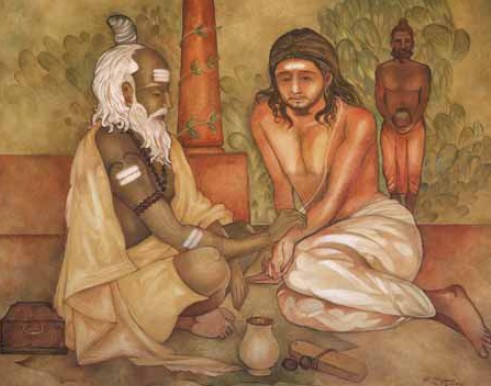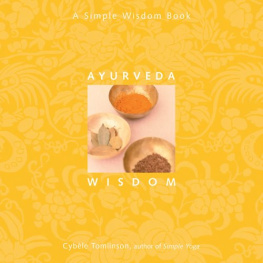ancient wisdoms,
todays practices
At no time in the history of the planet have Indias stress-busting, all-encompassing therapies had more importance. While we strive to improve material gains, we often neglect the spiritual, the physical and the mental. However, with stressful lifestyles taking their toll, taking time out to concentrate on ourselves is no longer a treat its a necessity. This is where Indias age-old traditional practices come in.
Whether you travel to India to visit a spa, to try to find yourself, to experience some medical care, or to spend some relaxing time with friends or family, you are almost certain to come across some of these ancient practices. Even though the country is modernizing at a rapid rate, everyone on some level or another is tied to its deep-rooted traditions.
Ancient Healing
Many of these age-old traditions are explored in this book. We get to the core of the countrys medical systems Ayurveda, Unani and Siddha and explore its history of herbal healing and ancient beauty procedures. The mind, body, spirit practices of yoga, meditation and pranayama are showcased in depth, while related cultural phenomena such as temple and household habits and gemology are also considered. Some of these ideas will be familiar to readers, others will be totally new. Well take you through the myriad of wonders that has emerged from this extraordinary, exotic subcontinent, all the while explaining how past wisdom has relevance in todays world.
Ayurveda and yoga are probably the most well known of the ancient modalities outside India and both seek to encompass much more than physical wellbeing. They are covered in depth in the ancient texts or Vedas and there are countless written instructions for both. Even though they werent traditionally practiced together, today they are finding synergy. Whats interesting about Indias systems, explains one Ayurvedic physician, is that they often incorporate more than one regime. Methods of healing like Ayurveda include a lifestyle regimen, yoga, aroma, meditation, gems, amulets, herbs, diet, jyotishi (astrology), color and more. It is this holistic approach that is so exciting.

Utilizing the purifying properties of mud is an ancient practice that continues in India to this day. Taking the earth element from the panchamahabhut or five great elements, it cleanses skin and boosts metabolism.
History of Ayurveda
Translated from Sanskrit as the Science of Life, Ayurveda was first mentioned in the verses of the Rig Veda , the first of the Vedas or Hindu sacred texts. Here there is reference to panchamahabhut (the five basic elements of the entire creation), and the three doshas or primary forces of prana or vata (air), agni or pitta (fire) and soma or kapha (water and earth) as comprising the basic principles of Ayurveda. However, there is much more detail in an upaveda (subsection) of the Atharva , the fourth Veda, written some time during 3,000 to 2,000 BC . Here, Ayurveda is documented more specifically: it is described as knowledge of self-healing or holistic healing, with the idea that everything is interrelated, yet still unique. The texts stated that if Ayurveda was applied on an individual basis in peoples everyday lives using diet, massage, oils, herbs and exercise, practitioners could be healthy and disease-free.

Wellness treatment being administered at the luxury spa at Amanbagh.

Taking the pulse is one of the first indicators in Ayurvedic diagnosis.
Around the turn of the first millennium BC the treatise known as the Charaka Samhita , the most referred Ayurvedic text on internal medicine, appeared. Believed to have been written by the great sage-physician Charaka, it explained the logic and philosophy of Ayurvedic medicine. Written in the form of a symposium wherein groups of Ayurvedic scholars take up a series of topics for discussion, it is written in verse in keeping with the Vedic oral tradition of conserving knowledge. It therefore seems likely that Ayurveda had been in existence for many hundreds, if not thousands, of years beforehand.

A spiritual ascetic or sadhu attends to a supplicant.

Yoga is recommended along with Ayurveda for total wellbeing.

A traditional Indian welcome.
Around the same time, the Sushruta Samhita appeared. It comprised knowledge about prosthetic surgery to replace limbs, cosmetic surgery, caesarian operations and even brain surgery. Sushruta is famous for his innovation of cosmetic surgery on the nose known as rhinoplasty, an interesting fact as he lived two centuries before Hippocrates, the Greek father of Western medicine. Around 500 AD , Vagbhata compiled the third major treatise on Ayurveda, Astanga Hridaya . It contained knowledge from both previous books, but also new information on diseases and cures. It is the text of choice for many practicing Ayurvedic physicians because it is a precise condensation of the two earlier texts.
There were, of course, many other useful reference texts, and it is documented that Ayurveda became entrenched in Indian life between 1,000 BC and 800 AD . Both Hindus and Buddhists maintained the academic progress of Ayurveda, and also ensured that the science was made as publicly available as possible. Medicinal herbs were planted, hospitals were formed, and the art of nursing (as described by Charaka) was widely systematized. But it wasnt until the Buddhist period (323 BC to 642 AD ) that Ayurveda began to be exported outside Indias shores. During this time Buddhist missionaries and monks took knowledge of Ayurveda, along with other aspects of Indian culture, to Europe (Rome and Greece), the Middle East (Baghdad) and China. Closer to home, the neighboring countries of Sri Lanka, Tibet, Thailand, Burma and Indonesia all accepted its teachings. In fact, its influence can still be seen in many of their healing systems: Acupressure, for example, is a direct descendent of marma massage.
In India, Ayurvedas heyday was probably from the 6th century to the 10th century AD : During this time, many universities and teaching hospitals were founded to cater to students from all over the world, and there are numerous references to the efficacy of the Indian system of medicine. But by the 12th century, Ayurvedas influence began to wane. Waves of Muslim invaders in northern India from the 10th to the 12th centuries burned books, destroyed hospitals and libraries, and slaughtered Hindu sages and Buddhist monks as infidels. They brought with them their own hakims or Unani doctors (a form of medicine formulated by Arabian physicians, see pages 3637) so the system fell into decline.

Early Ayurvedic texts were engraved on palm leaf manuscripts.






















